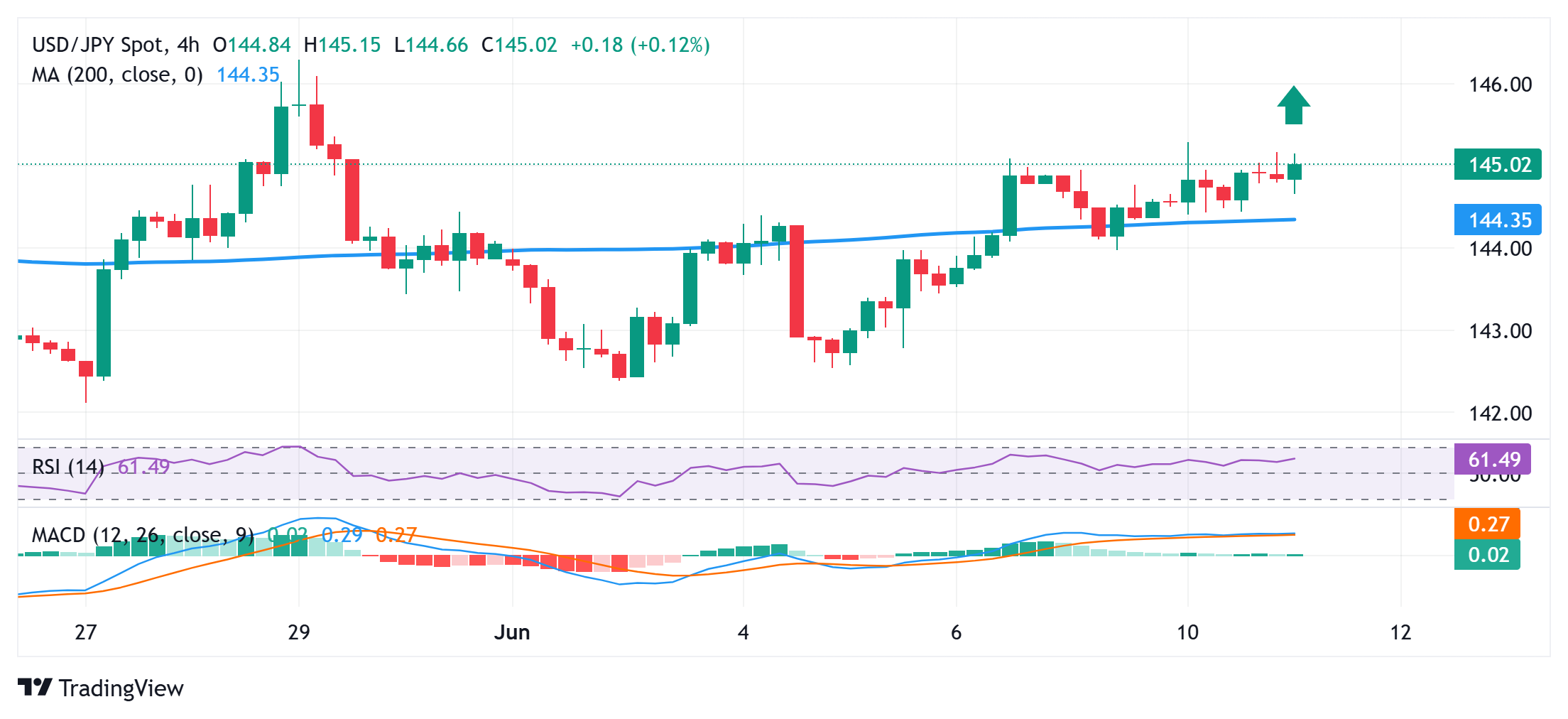Created
: 2025.06.11














![]() 2025.06.11 11:25
2025.06.11 11:25
The Japanese Yen (JPY) remains close to a nearly two-week low touched against its American counterpart the previous day, though any further decline seems elusive. The latest optimism over a positive outcome from US-China trade talks is seen as a key factor undermining the traditional safe-haven status of the JPY. Adding to this, a modest US Dollar (USD) uptick lifts the USD/JPY pair back above the 145.00 psychological mark during the Asian session on Wednesday.
However, a combination of factors should help limit deeper JPY losses. A federal appeals court ruled that US President Donald Trump's tariffs can remain in effect while legal appeals continue. This adds to a layer of uncertainty in the markets, which, along with bets that the Bank of Japan (BoJ) will continue raising interest rates, should act as a tailwind for the JPY. Moreover, dovish Federal Reserve (Fed) expectations should cap the Greenback and the USD/JPY pair.

From a technical perspective, acceptance above the 100-period Simple Moving Average (SMA) and positive oscillators on daily/hourly charts favor the USD/JPY bulls. However, repeated failures to build on momentum beyond the 145.00 psychological mark make it prudent to wait for some follow-through buying beyond the 145.30 area, or a two-week top touched on Tuesday, before positioning for further gains. Spot prices might then surpass the 145.60-145.65 intermediate hurdle and aim to reclaim the 146.00 round figure before climbing further towards the 146.25-146.30 region, or May 29 swing high.
On the flip side, the 200-period SMA on the 4-hour chart, currently pegged near the 144.30 area, might now protect the immediate downside ahead of the 144.00 mark. A convincing break below the latter will negate the positive outlook and shift the near-term bias in favor of the USD/JPY bears. The subsequent decline could drag spot prices down to the 143.60-143.50 region en route to sub-143.00 levels.
Generally speaking, a trade war is an economic conflict between two or more countries due to extreme protectionism on one end. It implies the creation of trade barriers, such as tariffs, which result in counter-barriers, escalating import costs, and hence the cost of living.
An economic conflict between the United States (US) and China began early in 2018, when President Donald Trump set trade barriers on China, claiming unfair commercial practices and intellectual property theft from the Asian giant. China took retaliatory action, imposing tariffs on multiple US goods, such as automobiles and soybeans. Tensions escalated until the two countries signed the US-China Phase One trade deal in January 2020. The agreement required structural reforms and other changes to China's economic and trade regime and pretended to restore stability and trust between the two nations. However, the Coronavirus pandemic took the focus out of the conflict. Yet, it is worth mentioning that President Joe Biden, who took office after Trump, kept tariffs in place and even added some additional levies.
The return of Donald Trump to the White House as the 47th US President has sparked a fresh wave of tensions between the two countries. During the 2024 election campaign, Trump pledged to impose 60% tariffs on China once he returned to office, which he did on January 20, 2025. With Trump back, the US-China trade war is meant to resume where it was left, with tit-for-tat policies affecting the global economic landscape amid disruptions in global supply chains, resulting in a reduction in spending, particularly investment, and directly feeding into the Consumer Price Index inflation.
![]()
Created
: 2025.06.11
![]()
Last updated
: 2025.06.11

FXStreet is a forex information website, delivering market analysis and news articles 24/7.
It features a number of articles contributed by well-known analysts, in addition to the ones by its editorial team.
Founded in 2000 by Francesc Riverola, a Spanish economist, it has grown to become a world-renowned information website.
We hope you find this article useful. Any comments or suggestions will be greatly appreciated.
We are also looking for writers with extensive experience in forex and crypto to join us.
please contact us at [email protected].
Disclaimer:
All information and content provided on this website is provided for informational purposes only and is not intended to solicit any investment. Although all efforts are made in order to ensure that the information is correct, no guarantee is provided for the accuracy of any content on this website. Any decision made shall be the responsibility of the investor and Myforex does not take any responsibility whatsoever regarding the use of any information provided herein.
The content provided on this website belongs to Myforex and, where stated, the relevant licensors. All rights are reserved by Myforex and the relevant licensors, and no content of this website, whether in full or in part, shall be copied or displayed elsewhere without the explicit written permission of the relevant copyright holder. If you wish to use any part of the content provided on this website, please ensure that you contact Myforex.
Myforex uses cookies to improve the convenience and functionality of this website. This website may include cookies not only by us but also by third parties (advertisers, log analysts, etc.) for the purpose of tracking the activities of users. Cookie policy